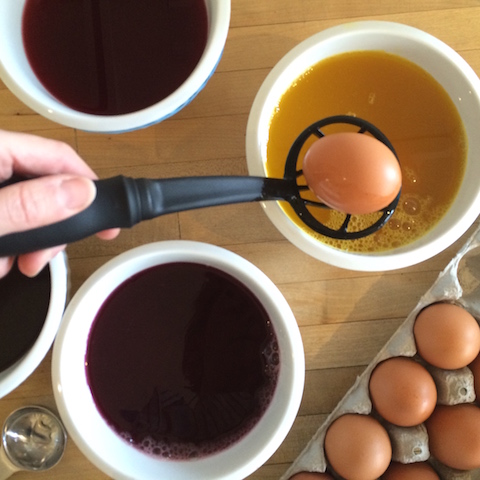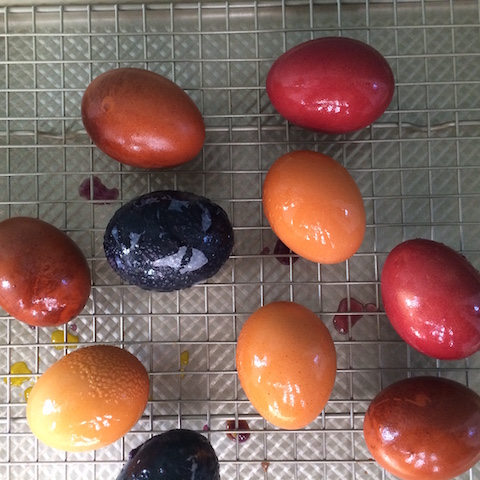Vegetable-Dyed Easter Eggs
Using various vegetables, fruits, vinegars and spices, you can create beautifully colorful and totally edible Easter Eggs for the annual hunt. These brown-shelled beauties take on a rich hue when left to soak in their "dye" overnight in the fridge, and now when you eat any leftovers, you know exactly what was in the fun coloring!
Have any other fun egg-dying know-how to share? Please post in the comments section!

In separate pots for different colors, boil your dye matter (about 3/4-1 cup is plenty) along with about 3 cups of water for up to an hour-- reducing all the while to thicken (you don't need to boil the cider, just skip to the next step.)
Strain out the solids from the dye and discard. Pour the liquid dye into bowls deep enough that the eggs will be submerged, and let cool. Stir in 1 tbsp white vinegar for every cup of liquid dye.
When the dye is almost cool, bring cold eggs and cold water to a boil. Cover and remove from heat, allow to rest for 12 minutes. Remove eggs from water, and while still warm, carefully slide them into the bowls of dye.*

Let the eggs sit up to 12hrs in the fridge in their dye-- the longer they sit, the richer the hue.
Very carefully remove the eggs from the dye bowls, and allow to drip dry on a rack. Try not to let them touch or rub with your fingers-- if you do peel off any film on the eggs they will have a pretty, mottled look but the color won't be as intense. Let them dry in the fridge if you're planning on eating them later. If you want to make them look shiny, rub in a drop of oil once totally dry.

*We've also heard of people having luck boiling the eggs directly into the dye material and water for 12 minutes, and allowing the whole thing to cool--eggs, water and dye material--together. After boiling, add the vinegar, and let the eggs and dye rest in the fridge overnight. In the morning, carefully remove the eggs and brush off any onion skins or grated beets, and allow to dry.
Ingredients
Directions
In separate pots for different colors, boil your dye matter (about 3/4-1 cup is plenty) along with about 3 cups of water for up to an hour-- reducing all the while to thicken (you don't need to boil the cider, just skip to the next step.)
Strain out the solids from the dye and discard. Pour the liquid dye into bowls deep enough that the eggs will be submerged, and let cool. Stir in 1 tbsp white vinegar for every cup of liquid dye.
When the dye is almost cool, bring cold eggs and cold water to a boil. Cover and remove from heat, allow to rest for 12 minutes. Remove eggs from water, and while still warm, carefully slide them into the bowls of dye.*

Let the eggs sit up to 12hrs in the fridge in their dye-- the longer they sit, the richer the hue.
Very carefully remove the eggs from the dye bowls, and allow to drip dry on a rack. Try not to let them touch or rub with your fingers-- if you do peel off any film on the eggs they will have a pretty, mottled look but the color won't be as intense. Let them dry in the fridge if you're planning on eating them later. If you want to make them look shiny, rub in a drop of oil once totally dry.

